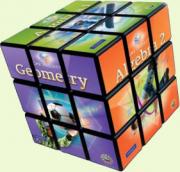
About the Program. The CME Project, developed by EDC’s Center for Mathematics Education and published by Pearson, is a coherent, four-year, NSF-funded high school mathematics program designed around how knowledge is organized and generated within mathematics: the themes of algebra, geometry, and analysis. The CME Project sees these branches of mathematics not only as compartments for certain kinds of results, but also as descriptors for methods and approaches—the habits of mind that determine how knowledge is organized and generated within mathematics itself. As such, they deserve to be centerpieces of a curriculum, not its by-products.
The Program’s Structure. The CME Project uses the traditional American structure of algebra, geometry, advanced algebra, and precalculus. Its primary goal is to develop in students robust mathematical proficiency. The problem-based, student-centered program builds on lessons learned from high-performing countries: develop an idea thoroughly and then revisit it only to deepen it; organize ideas in a way that is faithful to how they are organized in mathematics; and reduce clutter and extraneous topics. It also employs the best American models that call for struggling with ideas and problems as preparation for instruction, moving from concrete problems to abstractions and general theories, and situating mathematics in engaging contexts.
Core Principles. The CME Project is built around a few core principles:
- Habits of mind. For many high school students, the real utility of mathematics lies in a style of work—the habits of mind that allow one to look at the world through a mathematical lens.
- Textured emphasis. In the CME Project, we are careful to separate convention and vocabulary from matters of mathematical substance. Even our practice problems are designed to have a larger mathematical point.
- General purpose tools. Fluency in algebraic calculation, proof, and graphing are essential in mathematics, but special-purpose techniques, such as FOIL and the rote application of y = mx + b, are not.
- Experience before formality. Worked-out examples and careful definitions are important, but students need to grapple with ideas and problems before they are brought to closure.
- High expectations. The vast majority of students have the capacity to think in ways that are characteristically mathematical.
- A mathematical community. Our writers, field-testers, reviewers, and advisors come from all parts of the mathematics community: teachers, mathematicians, education researchers, technology developers, administrators, and students.
Example of Habits of Mind: Mathematical habits are developed throughout the text and include visualization, performing thought experiments, reasoning by continuity or linearity, and mixing deduction with experiment. How do you think about the following questions?
|
 |
Research on CME Project. All CME Project materials have been extensively field-tested in diverse classrooms across the country. During the development phase, the CME Project Development Team wrote and rewrote each lesson in response to the feedback from mathematicians and teachers, keeping mathematics and mathematical thinking at the heart of the work. Field-test teachers provided thorough, critical feedback that shaped draft lessons into realistic, teachable lessons. Independent research was conducted in each year of field-testing, and this research proved the CME Project was successful in raising student achievement.
